Hey everyone, new member here! I’m wanting to get a 5th gen (‘92-‘96) here soon, but I’d like to know more about them before jumping the gun. My dad had a bricknose when he was younger. But as he’s looking out for his daughter, he wants to hear from others. So, what do you recommend to look for and what to stay away from for this generation? TIA
You are using an out of date browser. It may not display this or other websites correctly.
You should upgrade or use an alternative browser.
You should upgrade or use an alternative browser.
What to look for and what to stay away from
- Thread starter s_pro__
- Start date
Disclaimer: Links on this page pointing to Amazon, eBay and other sites may include affiliate code. If you click them and make a purchase, we may earn a small commission.
Everyone has an opinion. LOL I think for the most part they are pretty solid trucks cheap to fix.
Myself I really like the trucks with Mass airflow. So in a 5.8 you need to get a 1996. In a 5.0 I think any of those years. 1993 and newer I believe had roller cams and last a lot longer.
But that is not saying older 5.8 is bad. But I sold a 1996 with 5.8 and 250k miles and it was still healthy. Running 14.5 mpg. Not burning oil, no signs of giving up.
Myself I really like the trucks with Mass airflow. So in a 5.8 you need to get a 1996. In a 5.0 I think any of those years. 1993 and newer I believe had roller cams and last a lot longer.
But that is not saying older 5.8 is bad. But I sold a 1996 with 5.8 and 250k miles and it was still healthy. Running 14.5 mpg. Not burning oil, no signs of giving up.
paul rondelli
Active member
plenty of parts out there..... most are easy pull and replace jobs.
The only thing that sucks is RUST.
If you're not sure what your pain tolerance is for rust ...... It should be absolutely Zero.
A 10,000 rust free Bronco from Arizona ...... will save you 100 hours of hours of rust repair.
The only thing that sucks is RUST.
If you're not sure what your pain tolerance is for rust ...... It should be absolutely Zero.
A 10,000 rust free Bronco from Arizona ...... will save you 100 hours of hours of rust repair.
L\Bronco
Well-known member
Welcome to the zone!Hey everyone, new member here! I’m wanting to get a 5th gen (‘92-‘96) here soon, but I’d like to know more about them before jumping the gun. My dad had a bricknose when he was younger. But as he’s looking out for his daughter, he wants to hear from others. So, what do you recommend to look for and what to stay away from for this generation? TIA
I agree with Tiha, a mass airflow engine will run better and more reliably. It will also definitely get better fuel economy.
96 would be my year of choice if I was in the market for one. (I'm partial to 2nd gen)
The last year of a model is usually the least problematic.
Plus 96 is OBD-2 compliant, so its way easier to talk to with a scan tool.
Good luck with the hunt!
Cheers
Yo s_pro__
Welcome to our Bronco community!
As advised by other members.
Note, 96 is same as most earlier years especially 92-95, except for:
92 through 95 uses the Electronic Engine Control, version Four (EEC-IV, aka On Board Diagnostics (OBD-I)) engine management computer.
96 uses the OBD-II (EEC-V) engine management computer;
4WABS (93-96);
RABS (87-92);
Air Bag (94-96);
3 Heated Exhaust Gas Oxygen Sensors in 96 Federal emissions and one more in 96 California Emissions
3 S C R E W Automatic Locking Hubs (Built from May 95 through 96); Spark Plug Wire Routing & Firing Order (The firing order for 1987-1993 5.0Ls is 1-5-4-2-6-3-7-8. The firing order for 1994- 96 5.0Ls & all 5.8Ls is 1-3-7-2-6-5-4-8.);
R134a in 94-96;
2-piece Spindle Rolling Diaphragm Seal (RDS) used on 5/95 to 96 Broncos & F Series 1/2-ton 4WD;
Ford added Crankshaft Position Sensor, aka misfire detection sensor and the tone ring in 96. The misfire sensor is an electromagnetic inductance coil similar in operation to a camshaft or crankshaft position sensor. A four-point stator, or pulse ring, located behind the crankshaft damper generates an electrical impulse in the sensor at each 90 degrees of rotation. The powertrain control module (PCM) (12A650) monitors the sensor pulses and flags any misfire events. When a specified number of misfires occur within a certain time frame, the powertrain control module will alert the driver to the condition by turning on the CEL.
Most 92-95 Speed Density (SD) EFI uses a Manifold Absolute Pressure Sensor (MAP), a Throttle Position Sensor (TPS) & an Air Intake Temperature Sender (ACT) that gives the engine certain volumetric efficiencies over it's RPM range. SD EFI also uses what is called bank fire injection. 4 injectors are fired at one time on each side of the engine (only 2 wires for firing injectors from EEC-IV).
Mass Air Electronic Fuel Injection (MAF), aka Sequential Electronic Fuel Injection (SEFI):
in all 94 5.0 & 95 5.0
most 95 5.8 are SD
95 5.0 & 4.9 & 5.8 California models are MAF
and all 96s are MAF.
Need to verify other Bronco years/engines.
Mass Air directly reads the mass of air (or number of molecules of air). By doing this, it can detect the changes in the volume of air, in addition to it's pressure & temperature. Mass air has one separate wire for each injector & fires them twice for every power stroke of the engine. This makes the injector timing more accurate & will help emissions along with power.
96 5.8 do not have the Air Injection (AIR), Secondary Air Injection; Pump (Smog Pump), Thermactor Air Bypass (TAB) & Thermactor Air Diverter (TAD) Solenoids; Diverter, Check & Bypass Valves, Cross-Over Tube, etc. But 96 5.0 does have the system.
Only 95 5.8L California models & all 96 have the Differential Pressure Feedback (DPFE) Sensor instead of EGR Valve Position (EVP) Sensor.
The 96, Vapor Management Valve (VMV) replaces the canister purge valve (CanP valve) used in EEC IV. But the 96 manual still shows CanP valve probably because it was a late addition to the 96 production line.
The Speed Control Deactivation Switch (SCDS) in a 93 Bronco is located on the driver side frame rail, but in 94 through 96 it is on the master cylinder.
Still researching other differences.
□
1990 302 5.0 to 1996 5.0 302 swap Parts Differences COMPENDIUM:
92 through 95 uses the Electronic Engine Control, version Four (EEC-IV, aka On Board Diagnostics (OBD-I)) engine management computer.
96 uses the OBD-II (EEC-V) engine management computer;
Ford added Crankshaft Position Sensor, aka misfire detection sensor and the tone ring in all 96 Broncos. The misfire sensor is an electromagnetic inductance coil similar in operation to a camshaft or crankshaft position sensor. A four-point stator, or pulse ring, located behind the crankshaft damper generates an electrical impulse in the sensor at each 90 degrees of rotation. The powertrain control module (PCM) (12A650) monitors the sensor pulses and flags any misfire events. When a specified number of misfires occur within a certain time frame, the powertrain control module will alert the driver to the condition by turning on the CEL.
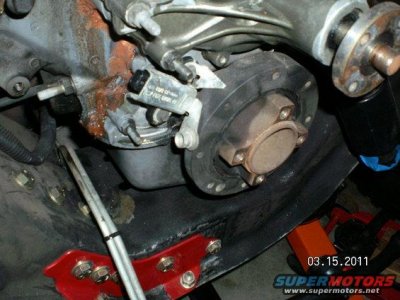
Location pic Misfire Sensor in a 96 next to the pointer by
92-95 Speed Density (SD) EFI uses a Manifold Absolute Pressure Sensor (MAP), a Throttle Position Sensor (TPS) & an Air Intake Temperature Sender (ACT) that gives the engine certain volumetric efficiencies over it's RPM range. SD EFI also uses what is called bank fire injection. 4 injectors are fired at one time on each side of the engine (only 2 wires for firing injectors from EEC-IV).
All 96s are MAF.
Mass Air directly reads the mass of air (or number of molecules of air). By doing this, it can detect the changes in the volume of air, in addition to it's pressure & temperature. Mass air has one separate wire for each injector & fires them twice for every power stroke of the engine. This makes the injector timing more accurate & will help emissions along with power.
MAF Sensor pic in a 95 58 w/CALIF Emissions, same location as a 96 5.0

by Subrubicon16
96 5.0 has the Air Injection (AIR), Secondary Air Injection; Pump (Smog Pump), Thermactor Air Bypass (TAB) & Thermactor Air Diverter (TAD) Solenoids; Diverter, Check & Bypass Valves, Cross-Over Tube, etc.
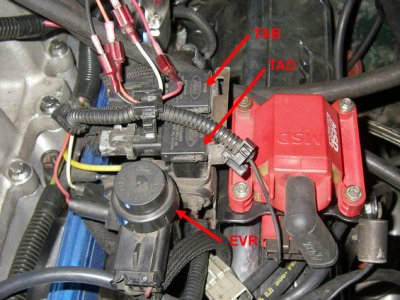
Pic by Seattle FSB in a 90.
Keep them all.
All 96s have the Differential Pressure Feedback (DPFE) Sensor instead of EGR Valve Position (EVP)
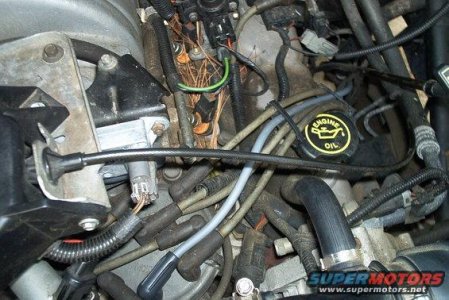
Location pic in a 96 5.0; Older Aluminum Rectangular Version, driver's side above distributor, next to throttle body & faces forward.
In 96, Vapor Management Valve (VMV) replaces the canister purge valve (CanP valve) used in EEC IV.

Pic by edamanski
Fuel Rated vacuum hose from VMV has small red tie wrap; it connects to throttle body just as the CanP did
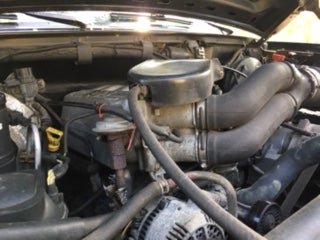
My much better-half couldn't snap pics of the cannister.
It's mounted on passenger side Firewall where earlier years MAP Sensor is located. Pull VMV and sell. Save Fuel Rated vacuum hoses if they are fuel rated.
●
Firing Orders & Spark Plug Wire Routing Diagrams;
5.0 Up to 93
& 94-96 ** & all year 5.8 Firing Order & Spark Plug Wire Routing Diagrams,
all 5.8 are same as ** in 94-96


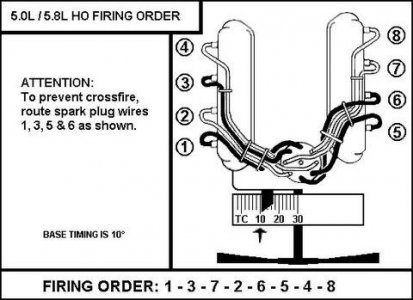
Engine Coolant Temperature (ECT) Sensor is same.
So is Temperature Gauge Sender.
In attached diagram, note that the Intake Air Temp (IAT); (Air Charge Temperature [ACT] prior to 1992)
After mid-1994 the ACT/IAT provision in the lower intake manifold was deleted on the 5.0L/5.8L engine and relocated to the air filter box. I believe this is when the name changed from Air Charge Temperature (ACT) sensor to Intake Air Temperature (IAT) sensor in order to indicate it's new location.
In general, the Bronco ACT Sensor is located on the lower intake manifold on Speed Density set-ups and the IAT Sensor is located in the air box on factory Mass Air Flow. These are the same sensors located at different locations with different PCM temperature programming values. This is one reason for some of the wiring harness differences between Speed Density and Mass Air Flow.
IAC appears different:
90 5.0 uses Motorcraft CX1838
96 5.0 uses CX1666
Throttle Position Sensor (TPS):
90 5.0 uses Cx1228
96 50.0 uses DY780
Throttle Bodies appear different because Throttle bodies and idle air by-pass valves on all EFI (Port Fuel Injection) engines through the 1992 model year can be cleaned. But for those throttle bodies identified as having sludge tolerant designs or using service kit (F2PZ-9F939-A) ,cleaning is not allowed.
In At Least 1996 5.0 & 5.8, a sealant/coating that is applied to the downstream side of the throttle body plate and bore to minimize closed plate to bore airflow. This sealant/coating should not be removed or cleaned. By Ford
Fuel Injection Pressure Regulators appear different
90 5.0 uses Standard Motor Products PR15
96 5.0. uses Standard Motor Products PR162
EGR Valves are Different
90 5.0 uses Standard Motor Products EGV263 and its EGR Valve Position Sensor is mounted above
96 5.0. uses Standard Motor Products EGV613, but doesn't need to have EGR Valve Position Sensor, because it uses DPFE Sensor.
EGR Vacuum Regulator (EVR); also called EGR Vacuum Solenoid are SAME
Positive Crankcase Ventilation Valve (PCV) are SAME
96 5.0 & 5.8 do not require a knock sensor, by Ford
Welcome to our Bronco community!
As advised by other members.
Note, 96 is same as most earlier years especially 92-95, except for:
92 through 95 uses the Electronic Engine Control, version Four (EEC-IV, aka On Board Diagnostics (OBD-I)) engine management computer.
96 uses the OBD-II (EEC-V) engine management computer;
4WABS (93-96);
RABS (87-92);
Air Bag (94-96);
3 Heated Exhaust Gas Oxygen Sensors in 96 Federal emissions and one more in 96 California Emissions
3 S C R E W Automatic Locking Hubs (Built from May 95 through 96); Spark Plug Wire Routing & Firing Order (The firing order for 1987-1993 5.0Ls is 1-5-4-2-6-3-7-8. The firing order for 1994- 96 5.0Ls & all 5.8Ls is 1-3-7-2-6-5-4-8.);
R134a in 94-96;
2-piece Spindle Rolling Diaphragm Seal (RDS) used on 5/95 to 96 Broncos & F Series 1/2-ton 4WD;
Ford added Crankshaft Position Sensor, aka misfire detection sensor and the tone ring in 96. The misfire sensor is an electromagnetic inductance coil similar in operation to a camshaft or crankshaft position sensor. A four-point stator, or pulse ring, located behind the crankshaft damper generates an electrical impulse in the sensor at each 90 degrees of rotation. The powertrain control module (PCM) (12A650) monitors the sensor pulses and flags any misfire events. When a specified number of misfires occur within a certain time frame, the powertrain control module will alert the driver to the condition by turning on the CEL.
Most 92-95 Speed Density (SD) EFI uses a Manifold Absolute Pressure Sensor (MAP), a Throttle Position Sensor (TPS) & an Air Intake Temperature Sender (ACT) that gives the engine certain volumetric efficiencies over it's RPM range. SD EFI also uses what is called bank fire injection. 4 injectors are fired at one time on each side of the engine (only 2 wires for firing injectors from EEC-IV).
Mass Air Electronic Fuel Injection (MAF), aka Sequential Electronic Fuel Injection (SEFI):
in all 94 5.0 & 95 5.0
most 95 5.8 are SD
95 5.0 & 4.9 & 5.8 California models are MAF
and all 96s are MAF.
Need to verify other Bronco years/engines.
Mass Air directly reads the mass of air (or number of molecules of air). By doing this, it can detect the changes in the volume of air, in addition to it's pressure & temperature. Mass air has one separate wire for each injector & fires them twice for every power stroke of the engine. This makes the injector timing more accurate & will help emissions along with power.
96 5.8 do not have the Air Injection (AIR), Secondary Air Injection; Pump (Smog Pump), Thermactor Air Bypass (TAB) & Thermactor Air Diverter (TAD) Solenoids; Diverter, Check & Bypass Valves, Cross-Over Tube, etc. But 96 5.0 does have the system.
Only 95 5.8L California models & all 96 have the Differential Pressure Feedback (DPFE) Sensor instead of EGR Valve Position (EVP) Sensor.
The 96, Vapor Management Valve (VMV) replaces the canister purge valve (CanP valve) used in EEC IV. But the 96 manual still shows CanP valve probably because it was a late addition to the 96 production line.
The Speed Control Deactivation Switch (SCDS) in a 93 Bronco is located on the driver side frame rail, but in 94 through 96 it is on the master cylinder.
Still researching other differences.
□
1990 302 5.0 to 1996 5.0 302 swap Parts Differences COMPENDIUM:
92 through 95 uses the Electronic Engine Control, version Four (EEC-IV, aka On Board Diagnostics (OBD-I)) engine management computer.
96 uses the OBD-II (EEC-V) engine management computer;
Ford added Crankshaft Position Sensor, aka misfire detection sensor and the tone ring in all 96 Broncos. The misfire sensor is an electromagnetic inductance coil similar in operation to a camshaft or crankshaft position sensor. A four-point stator, or pulse ring, located behind the crankshaft damper generates an electrical impulse in the sensor at each 90 degrees of rotation. The powertrain control module (PCM) (12A650) monitors the sensor pulses and flags any misfire events. When a specified number of misfires occur within a certain time frame, the powertrain control module will alert the driver to the condition by turning on the CEL.

Location pic Misfire Sensor in a 96 next to the pointer by
92-95 Speed Density (SD) EFI uses a Manifold Absolute Pressure Sensor (MAP), a Throttle Position Sensor (TPS) & an Air Intake Temperature Sender (ACT) that gives the engine certain volumetric efficiencies over it's RPM range. SD EFI also uses what is called bank fire injection. 4 injectors are fired at one time on each side of the engine (only 2 wires for firing injectors from EEC-IV).
All 96s are MAF.
Mass Air directly reads the mass of air (or number of molecules of air). By doing this, it can detect the changes in the volume of air, in addition to it's pressure & temperature. Mass air has one separate wire for each injector & fires them twice for every power stroke of the engine. This makes the injector timing more accurate & will help emissions along with power.
MAF Sensor pic in a 95 58 w/CALIF Emissions, same location as a 96 5.0
by Subrubicon16
96 5.0 has the Air Injection (AIR), Secondary Air Injection; Pump (Smog Pump), Thermactor Air Bypass (TAB) & Thermactor Air Diverter (TAD) Solenoids; Diverter, Check & Bypass Valves, Cross-Over Tube, etc.

Pic by Seattle FSB in a 90.
Keep them all.
All 96s have the Differential Pressure Feedback (DPFE) Sensor instead of EGR Valve Position (EVP)

Location pic in a 96 5.0; Older Aluminum Rectangular Version, driver's side above distributor, next to throttle body & faces forward.
In 96, Vapor Management Valve (VMV) replaces the canister purge valve (CanP valve) used in EEC IV.

Pic by edamanski
Fuel Rated vacuum hose from VMV has small red tie wrap; it connects to throttle body just as the CanP did

My much better-half couldn't snap pics of the cannister.
It's mounted on passenger side Firewall where earlier years MAP Sensor is located. Pull VMV and sell. Save Fuel Rated vacuum hoses if they are fuel rated.
●
Firing Orders & Spark Plug Wire Routing Diagrams;
5.0 Up to 93
& 94-96 ** & all year 5.8 Firing Order & Spark Plug Wire Routing Diagrams,
all 5.8 are same as ** in 94-96



Engine Coolant Temperature (ECT) Sensor is same.
So is Temperature Gauge Sender.
In attached diagram, note that the Intake Air Temp (IAT); (Air Charge Temperature [ACT] prior to 1992)
After mid-1994 the ACT/IAT provision in the lower intake manifold was deleted on the 5.0L/5.8L engine and relocated to the air filter box. I believe this is when the name changed from Air Charge Temperature (ACT) sensor to Intake Air Temperature (IAT) sensor in order to indicate it's new location.
In general, the Bronco ACT Sensor is located on the lower intake manifold on Speed Density set-ups and the IAT Sensor is located in the air box on factory Mass Air Flow. These are the same sensors located at different locations with different PCM temperature programming values. This is one reason for some of the wiring harness differences between Speed Density and Mass Air Flow.
IAC appears different:
90 5.0 uses Motorcraft CX1838
96 5.0 uses CX1666
Throttle Position Sensor (TPS):
90 5.0 uses Cx1228
96 50.0 uses DY780
Throttle Bodies appear different because Throttle bodies and idle air by-pass valves on all EFI (Port Fuel Injection) engines through the 1992 model year can be cleaned. But for those throttle bodies identified as having sludge tolerant designs or using service kit (F2PZ-9F939-A) ,cleaning is not allowed.
In At Least 1996 5.0 & 5.8, a sealant/coating that is applied to the downstream side of the throttle body plate and bore to minimize closed plate to bore airflow. This sealant/coating should not be removed or cleaned. By Ford
Fuel Injection Pressure Regulators appear different
90 5.0 uses Standard Motor Products PR15
96 5.0. uses Standard Motor Products PR162
EGR Valves are Different
90 5.0 uses Standard Motor Products EGV263 and its EGR Valve Position Sensor is mounted above
96 5.0. uses Standard Motor Products EGV613, but doesn't need to have EGR Valve Position Sensor, because it uses DPFE Sensor.
EGR Vacuum Regulator (EVR); also called EGR Vacuum Solenoid are SAME
Positive Crankcase Ventilation Valve (PCV) are SAME
96 5.0 & 5.8 do not require a knock sensor, by Ford
Last edited:
Thank you very much for the response and advice, I appreciate it!!Everyone has an opinion. LOL I think for the most part they are pretty solid trucks cheap to fix.
Myself I really like the trucks with Mass airflow. So in a 5.8 you need to get a 1996. In a 5.0 I think any of those years. 1993 and newer I believe had roller cams and last a lot longer.
But that is not saying older 5.8 is bad. But I sold a 1996 with 5.8 and 250k miles and it was still healthy. Running 14.5 mpg. Not burning oil, no signs of giving up.
Everyone has an opinion. LOL I think for the most part they are pretty solid trucks cheap to fix.
Myself I really like the trucks with Mass airflow. So in a 5.8 you need to get a 1996. In a 5.0 I think any of those years. 1993 and newer I believe had roller cams and last a lot longer.
But that is not saying older 5.8 is bad. But I sold a 1996 with 5.8 and 250k miles and it was still healthy. Running 14.5 mpg. Not burning oil, no signs of giving up.
goodO1boydws
Active member
More like 1000 hours......plenty of parts out there..... most are easy pull and replace jobs.
The only thing that sucks is RUST.
If you're not sure what your pain tolerance is for rust ...... It should be absolutely Zero.
A 10,000 rust free Bronco from Arizona ...... will save you 100 hours of hours of rust repair.
ragtop69
Member
I've got a '95 5.8L but, if I had it to do over I would probably have bought a '96 if only for the OBD-2 on board computer. I had an '83 XLT with a carb and a 5.0L and it ran like a champ after 17 years and 177K miles. I really like the extra power the 5.8 L provides and the EFI. My '95 now has 176K on the clock and runs like a new truck.
johnnyreb
Well-known member
I bought 2--78 bronco at different times . One needed the brakes fixed. I rebuilt the front axle and ran it a good while before it the oil pressure dropped and now I,m in the process of rebuilding the motor. The second one looked good and I really bought it for the bumper and fender. That I needed for the other one.It also had a bad 35 in it.After looking at the GOOD BODY. I decided to get a motor for it. In the spring I crawled under it---I looked like EVERYTHING WAS WORE OUT. They even tore the rear sway bar off. Don,t ask me how they did it. I started replacing parts and it has been a big money pit. NO MATTER HOW SHARP IT LOOKS---CHECK EVERYTHING OUT ON IT--OR HAVE SOMEONE YOU KNOW AND CAN TRUST--TO HELP YOU OUT. Welcome to the club and good luck.
Wishmeluck
Member
My .02, without a doubt stay away from anything with rust. All the other stuff is nuts/bolts and 12 volts, but rust is a whoooooole nother level of headache thats just not worth it.
johnnyreb
Well-known member
Well I have seen some nice looking vehicles--all shiney and was alot of troubles. LOOKS CAN BE DECEIVING. If you find one --that looks bad and needs a good bit of work---can be something that can teach you a trade . To start working on it and learn something from working on it. What would you know what to do---if it stopped running one day you were out? If you NEVER worked on it you wouldn,t know what to check.My .02, without a doubt stay away from anything with rust. All the other stuff is nuts/bolts and 12 volts, but rust is a whoooooole nother level of headache thats just not worth it.
Similar threads
- Replies
- 2
- Views
- 1K
- Replies
- 2
- Views
- 440
